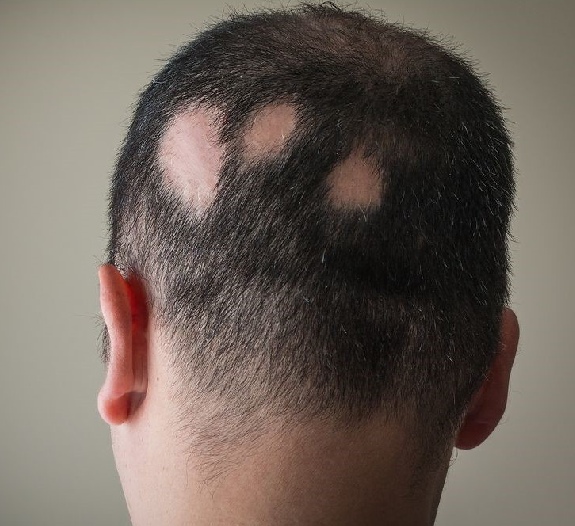
Non-Scarring Alopecia (Non Cicatricial Alopecia)
This type of alopecia is a group of hair disorder, in which there is no permanent damage to hair follicles and non-scarring alopecia can be of various types, including:
1. Alopecia Areata
This a condition in which round patches of hair loss appear suddenly. In alopecia areata, the hair follicle is attacked by the patient's own immune cells for unknown reasons (autoimmune). There are three stages: first, there is sudden hair loss, then the patches of hair loss enlarge, and in the last stage, new hair grows back. This whole process may take months, sometimes more than a year, but rarely does the hair ever grow back. So, the prognosis is usually good.
To treat this condition dermatologists may recommend topical, systemic medications as well as injections. Mostly, localized steroid injections can be given into the patch to speed up hair growth. Potent topical steroids (if the patient is not willing for injection) with or without minoxidil (2% or 5% lotion) can also be given. Oral steroids can be given in an extensive and rapidly progressive form, in pulse or daily doses.
2. Diffuse Alopecia
The most common cause of diffuse alopecia is telogen effluvium. In this condition, there is a sudden loss of telogen hair in large amounts after a couple of months of illness or major surgery. This type of hair loss is related to the stress of the illness and is mostly temporary.
Hormonal problems may also cause diffuse hair loss. Another reason for hair shedding can be overactive or underactive thyroid gland. In such a case, thyroid treatment must be taken to reduce hair loss. Hair loss can also occur due to an imbalance of male or female hormones namely androgens and estrogens. Many women notice hair loss about 3 months after delivery but after 3-4 months of shedding, the normal cycle of growth is restored.
Some medicines can also cause hair loss which includes blood thinners (anticoagulants), medications used for gout, medicines used for chemotherapy to treat cancer, vitamin A (if taken in high doses), birth control pills and antidepressants.
Certain fungal infections of the scalp can cause hair loss in children. This infection is easily treated with antifungal medication. Finally, diffuse hair loss may occur as part of an underlying disease, such as diabetes.
3. Androgenic Alopecia
Androgenic alopecia can affect both males and females. The most common cause of hair loss in men is male-pattern baldness. Men who have this type of hair loss usually have a family history. Male patients, who start losing their hair at an early age tend to develop more extensive and rapid baldness. In this, hair loss typically results in a receding hairline and baldness on the top of the head.
Women also may develop female-pattern baldness. Most common in females aged 20-40 years. There can be three types of female patterns of hair loss have been described :
1. Diffuse central thinning
2. Frontal accentuation
3. The frontotemporal recession of the hairline
Depending on the type of hair loss, many treatments are available. For men, having mild to moderate hair loss, particularly involving the frontal area, topical minoxidil 5%- 10% be used. For prominent frontal recession oral finasteride (1mg per day) is presently the drug of choice, along with minoxidil. For men with severe grades of alopecia, surgical options like hair transplants can be considered. Basis the severity of hair loss, minoxidil 2% lotion and oral finasteride (2.5- 5mg per day) may be suggested for women.
Improper care of hair can cause hair loss
Breakage of hair can occur due to frequent handling of the hair with hair styling devices and may lead to dry and brittle hair that can break easily. Medically, the term ‘traction alopecia’ is used for the kind of hair loss that occurs due to tight rubber bands, tight hair rollers that pull on the hair. If the pulling is stopped before the scarring of the scalp develops on affected areas, the hair will grow back normally. However, scarring can cause permanent hair loss. Chemicals used in permanent hair treatments (also called "perms") may cause inflammation or damage to the hair follicle, which can result in scarring and hair loss.
Role of diet in hair loss
If the diet is low in essential nutrients like iron, folic acid, biotin, vitamin B12, vitamin D3, calcium, etc. then it can be a cause of hair loss. These nutrients play a very important role in the hair growth cycle, so their deficiencies can cause hair loss.
Scarring Alopecia (Cicatricial Alopecia)
In cicatricial alopecia, scarring is characteristic and hair follicles have been destroyed permanently, so hair cannot regrow. Causes for this type of scarring alopecia include diseases like discoid lupus, lichen planus, folliculitis de calvans of scalp, morphoea with involvement of the scalp. Any form of medical treatment is ineffective except in very early cases where immunomodulators and oral cortisone may help control the disease.
 Whatsapp
Whatsapp Facebook
Facebook Twitter
Twitter Instagram
Instagram Linkedin
Linkedin Pinterest
Pinterest